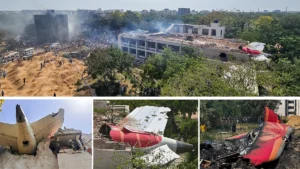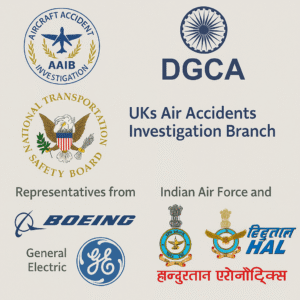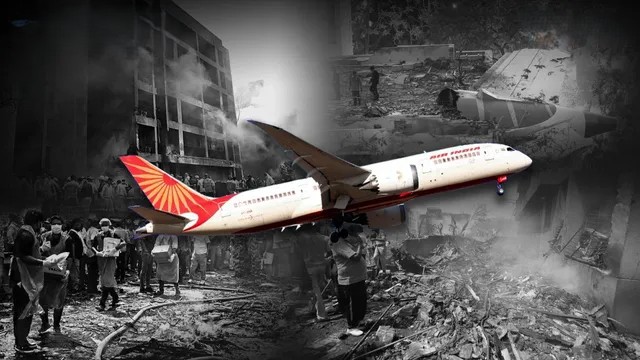On June 12, 2025, Air India Flight 171, a Boeing 787‑8 Dreamliner flying from Ahmedabad to London, crashed just 30 seconds after takeoff—killing 260 people onboard and 19 on the ground. Only one passenger miraculously survived. A preliminary report from the Aircraft Accident Investigation Bureau (AAIB) has now revealed disturbing new details that could change the face of aviation safety forever. Here’s everything you need to know from the latest Air India crash updates.

Inside the Air India Plane Crash Report
The Air India preliminary report has highlighted a shocking sequence of events:
Both engine fuel control switches were moved from RUN to CUTOFF just seconds after liftoff, resulting in instantaneous engine failure.
The cockpit crew tried to restore the switches to RUN, but the aircraft had already lost critical altitude and time.
Cockpit voice recordings reveal confusion in the final seconds, with one pilot reportedly asking, “Why did you cut the fuel?”—to which the other pilot replied, “I didn’t.”
The Ram Air Turbine (RAT) deployed midair, confirming a total power failure.
There were no signs of bird strikes, bad weather, or external sabotage.
The engines were recently serviced and found to be in good condition.
Investigators noted a previous FAA bulletin warning about potential design flaws in fuel control safety, which had not been addressed by the airline.
Human Error or System Failure?
The central mystery remains: how did both fuel switches get turned off simultaneously?
Fuel cutoff switches are protected by safety guards and require deliberate manual effort to activate. Investigators have stated that it’s unlikely to be accidental, sparking major questions:
Was this a pilot error under pressure?
Could there have been a mechanical or electrical malfunction?
Is sabotage completely ruled out?
So far, the report does not confirm whether the switches were moved intentionally or whether a malfunction bypassed the safety mechanisms. It’s a rare and deeply alarming scenario.
Air India Flight Crash Investigation: Who’s Involved?

The Air India crash investigation is one of the most collaborative in India’s aviation history. The following bodies are involved:
Aircraft Accident Investigation Bureau (AAIB)
Directorate General of Civil Aviation (DGCA)
United States National Transportation Safety Board (NTSB)
UK’s Air Accidents Investigation Branch
Representatives from Boeing and General Electric (GE)
Indian Air Force and Hindustan Aeronautics Limited (HAL)
The black boxes were recovered within days, and initial data from the cockpit voice recorder was decrypted by June 25. The level of cooperation across international agencies highlights the gravity of this crash.
Timeline of the Air India 171 Crash
| Time (UTC) | Event Description |
|---|---|
| 08:08:39 | Flight 171 takes off from Ahmedabad. |
| 08:08:42 | Engines reach top airspeed; both fuel switches turned OFF. |
| Seconds later | Fuel switches moved back to RUN by pilots. |
| 08:08:47 | RAT (emergency power) deploys. |
| 08:09:05 | ‘MAYDAY’ distress call issued. |
| 08:09:15 | Aircraft crashes into a nearby hostel building. |
The entire flight lasted just over 30 seconds—a terrifyingly short window in which tragedy unfolded.
Aviation Experts React
The aircraft’s behavior has stunned aviation professionals worldwide:
Several industry veterans have called the dual-engine cutoff “unprecedented” in the context of takeoff.
Experts say that even one engine flameout is rare, let alone both at once, and right after takeoff.
The cockpit voice recording shows clear signs of panic and confusion, indicating the pilots were unaware of what triggered the loss of power.
There are also discussions about a possible latent software or switch design issue.
One thing is clear: this was not a typical mechanical failure.
Families Demand Transparency
As the Air India crash report goes public, families of the victims are demanding full transparency:
Many are questioning how such a critical failure could occur without early warning signs.
The lack of clear answers in the preliminary findings has sparked frustration.
Some families are now considering legal action against Air India and Boeing for negligence or design flaws.
Their grief has turned into a desperate plea for accountability and systemic change.
Boeing and Air India Under Pressure

The preliminary report has cast a spotlight on both Air India and Boeing:
Boeing had previously issued a service bulletin addressing a potential risk involving the fuel switch mechanism. This warning wasn’t acted on across all airlines.
Air India, now owned by the Tata Group, faces mounting criticism over its maintenance records, pilot training standards, and compliance with manufacturer advisories.
The DGCA has since ordered a complete inspection of all Boeing 787‑8 Dreamliners in its registry, with a specific focus on fuel management systems.
This crash may force major revisions in Boeing’s fuel switch design and retrofits across global fleets.
What Comes Next?
The final Air India crash report is expected within the next 6–12 months. Here’s what investigators are now focusing on:
Digital analysis of the Flight Data Recorder (FDR) to trace every system response.
Interviews with maintenance teams and technical documentation audits.
Further simulation testing was conducted to determine whether pilot action or failure was more probable.
Exploration of possible electromagnetic interference, software glitches, or crew incapacitation.
Until then, global aviation authorities will remain on high alert for any systemic risks this crash may reveal.
The Future of Aviation Safety in India
This tragedy has already led to major discussions in India’s aviation sector:
Calls for mandatory pilot simulator training for worst-case engine scenarios.
Proposals to redesign fuel switch placement and locking mechanisms.
Potential for India to adopt more rigorous maintenance audit systems like those used in the U.S. and Europe.
Rise in passenger anxiety, with travel forums reporting drops in bookings on similar aircraft types.
India’s booming aviation industry is now under scrutiny, and rightly so. The pressure to act is intense.
Why Air India Flight 171 Will Be Remembered
The Air India 171 crash will go down in history as one of the most baffling and tragic aviation disasters in modern Indian aviation. Its implications stretch far beyond one flight—this event is likely to change how fuel systems are designed, how maintenance is tracked, and how emergency preparedness is taught.
For the families who lost loved ones, the truth can’t come soon enough. And for the flying public, the question remains:
How do we prevent this from ever happening again?
To get more updates visit: The Morning Draft

